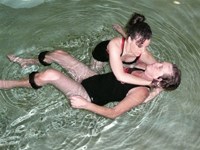






"People come in different sizes, shapes, and physical conditions. Water equalises them all. Aquatic Bodywork is therefore suitable for almost anyone in any age group. It's an accessible, low-threshold activity and you don't have to be able to swim," says Maria Gerondoudis, therapist and owner of the Aquatic Bodywork facility at Morningside Medi-Clinic in Johannesburg.
The buoyancy of water supports the body, counterbalancing the effect of gravity which relieves strain on muscles and joints. In addition, warm water provides constant sensory stimulation to the body which has a sedative effect and reduces pain sensitivity. Since the pain is less, patients can exercise safely, move more easily and are more receptive to manipulation and stretching. As muscles relax, physical and emotional tension is reduced.
"Patients can do in water what they cannot do on land. Joints that were restricted by weight-bearing on land are now free to be moved and stretched in a physiological way," Maria explains.
Hydrotherapy itself is an age-old form of therapy and is an accepted and popular way to treat various conditions. Both active and passive hydrotherapy techniques are used and tailored for the client's specific needs. The active work aims at improving strength and stamina, building muscle mass in weak areas, stabilising joints and restoring range of motion. The primary difference between Aquatic Bodywork and the type of hydrotherapy that has existed and been used in South Africa until now is that it uses passive bodywork techniques where the client does absolutely nothing but float: the therapist is in the water with the client throughout the session using gentle traction, stretches, mobilisations, realignment techniques, acupressure massage, movement and stillness. When used at the end of an active session, these bodywork techniques have shown to accelerate muscle recovery and reduce the risk of stiffness and inflammation.
"Aquatic bodywork is different to traditional hydrotherapy in that the aquatic bodywork practitioner holds the client completely supported in his or her arms, body or with float assistance. The therapist then moves every joint in every limb, including the torso with rhythmic movements through the water. Massaging pressures and stretches are given in a specific sequence and as is required by the patient and understood through the therapist's sense of the client's needs. At the same time the therapist constantly observes his or her client for discomfort or ability to allow the movements," explains physiotherapist Phyllis Berger. "Patients or clients with disabilities, muscle spasms and or pain that is resistant to treatment on land due to fear or resistance is alleviated by the comfort of support by the therapist and the safety and ease of movement in the warm water environment.
The warm temperature of the water (about 32 or 33 degrees) is also healing and relieves pain and muscle spasm. Therefore some remarkable improvements can be made in very difficult patients, even those with cerebral palsy, strokes and failed back syndromes to mention a few."
Aquatic Bodywork can also be beneficial for children. "I have seen benefits from hydrotherapy in the children I treat with arthritis, especially those who have high levels of pain. I refer almost all the children I see for physical therapy of some kind, as it speeds up the healing and helps control pain in the inflammatory disease," says Dr Gail Faller, a pediatric rheumatologist from Johannesburg.
In a study conducted locally amongst 25 patients with varying pain conditions who were each given questionnaires and assessed before and after treatment sessions, 24 of the 25 patients reported increased range of motion, particularly in the hips, knees, ankles and spine. In summary, hydrotherapy helped these patients, who each had varying lengths of therapy, to alleviate their pain condition which improved their quality of life. All 25 patients said that they would recommend hydrotherapy for other patients who had been diagnosed with similar conditions to their own.
People with chronic pain conditions such as arthritis, fibromyalgia, rheumatism, back injuries, osteoporosis and multiple sclerosis have seen extraordinary results with Aquatic Bodywork.
One or consecutive sessions of warm water therapy, performed by a qualified Aquatic Bodywork therapist, can reduce blood pressure, diminish muscular tensions, increase flexibility and range of motion, extend the vertebral column, improve posture, circulation, breathing and sleeping patterns, reduce depression and stress, address addictive patterns, emotional and psychological traumas, alleviate spinal and muscular tension and reduce acute and chronic pain.
Occupational therapist Jenny Feinstein was introduced to Aquatic Bodywork by her physiotherapist following a fractured femur.
"This left me totally debilitated. I was dependent on other people for all my needs. I was depressed and had lost my confidence. Hydrotherapy gave me the boost that I so badly needed. I could move normally in the water and I felt that I would be able to move and even walk again! Hydrotherapy really does fulfill both the physical and emotional needs of the person who is experiencing difficulties of movement whatever their diagnosis may be," she says.
As an occupational therapist Feinstein says that she has learnt that the patient must be treated as a totality i.e. both physically and well as psychologically/emotionally.
"Aquatic Bodywork meets these needs very well. The person is buoyant in the water making movement easier. At the same time muscle strength and joint mobility are also improved. This is graded by the therapist who is skilled in this area. She will increase the number of repetitions and resistance given to the patient in the each exercise. I can see that there are many benefits from hydrotherapy and recommend that other people in the medical profession consider this as an option when dealing with problems of this nature," Feinstein explains.
Aquatic bodywork, while common in North America, Europe, Australia, New Zealand, Brazil, Israel, and Japan, is still very new in South Africa, with only four practitioners in Johannesburg and one in Cape Town at present.
For more information, go to www.aquaticbodywork.co.za.